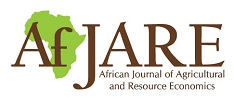All Articles
- All
- Special Issue
- Volume 13-1
- Volume 13-2
- Volume 13-3
- Volume 14-1
- Volume 14-2
- Volume 14-3
- Volume 14-4
- Volume 15-1 (March 2020)
- Volume 15-2 (June 2020)
- Volume 15-3 (September 2020)
- Volume 15-4 (December 2020)
- Volume 16-1 (March 2021)
- Volume 16-2 (June 2021)
- Volume 16-3 (September 2021)
- Volume 16-4 (December 2021)
- Volume 17-1 (March 2022)
- Volume 17-2 (June 2022)
- Volume 17-3 (September 2022)
- Volume 17-4 (December 2022)
- Volume 18-1
- Volume 18-2 (June 2023)
- Volume 18-3
- Volume 19-1
- Volume 19-2
- Volume 19-3
- Volume 19-4
- Volume 20-1
- Volume 20-2
- Volume 20-3
- Volume 20-4
- Volume 8-1
- Volume 8-3
Sustainable food systems are necessary not only as a channel for addressing the food security needs of the world’s growing population, but are also crucial in ensuring that the needs of future generations are not compromised.
This is a special issue of the African Journal of Agricultural and Resource Economics (AfJARE), with papers contributed by the faculty members of the Collaborative Master’s in Agricultural and Applied Economics (CMAAE), one of the collaborative training programmes of the African Economic Research Consortium (AERC).
The recent increase in farmland investments in developing countries by private equity funds, large multinationals and sometimes foreign governments has attracted widespread attention and strong emotions from various interest groups.
Consumers are increasingly becoming very concerned about food safety, with many giving preference to organic food products over conventional food products, which make use of agrochemicals with potential implications for health.
Agricultural digitisation is one of the key drivers of agricultural development, as well as of rapid economic growth, in many countries. This study aims to investigate the causal links between agricultural digitisation and high-quality agricultural development in the context of developed and developing countries.
This paper examines determinants of the adoption of rainwater-harvesting technologies in a rain shadow area of southern Malawi. The most common ex situ technologies in the area were dams, and the widely used in situ technologies were box ridges, contour markers and swales.
Cette étude explore l’effet de l’intégration des pays africains aux chaînes de valeur agricoles sur la sécurité alimentaire, en soulignant le rôle central des institutions.
This study applied the zero-inefficiency stochastic frontier (ZISF) to analyse the technical efficiency of 333 improved rice-farming households for the 2012/2013 farming season in Ghana.
Does commercialisation drive technical efficiency improvements in Ethiopian subsistence agriculture?
The conditions in which increased market participation leads to improved technical efficiency are still not adequately understood. This study therefore investigated farmers’ market participation rates and their predicted technical efficiency scores by performing a two-stage least squares (2SLS) regression analysis using household-level data obtained from the 2009 Ethiopian rural household survey.
This paper evaluates the extent to which changes in international wheat prices are transmitted to domestic markets in Kenya using an error correction model (ECM) that employs monthly producer price data for the period 2002 to 2020. Domestic wheat markets in Kenya were found to be strongly integrated while, international wheat markets were cointegrated with domestic prices at the port of Mombasa.
En partant du postulat que le financement agricole contribue de manière significative à la production agricole, cet article analyse les liens entre ressources mobilisées pour le secteur et la sécurité alimentaire au Sénégal.
Cet article analyse les effets des produits forestiers non ligneux (PFNL) sur la pauvreté multidimensionnelle au Burkina Faso. Il s'appuie sur des données primaires collectées auprès de 384 ménages sélectionnés aléatoirement.
Nutrition knowledge is an important driver of household dietary diversity that can be improved through access to nutrition information. However, in many rural areas, the formal flow of nutrition information is limited, although social networks could play an important role as an informal source of such information.
Climate-smart agriculture (CSA) is viewed as a potentially effective intervention to address low agricultural productivity in Sub-Saharan Africa (SSA), while strengthening farmers’ capacity to adapt to the effects of climate change.
We look at the prioritisation of agricultural value chains (VCs) for the allocation of R&D resources that maximise development outcomes (poverty, growth, jobs and diets) in Senegal.
Improving local rice production capacity is a key element on the agenda of most countries in the West African Economic and Monetary Union (WAEMU).
There is an emerging body of studies assessing the influence of resilience on household food security in developing countries. Yet no study has systematically analysed this theme in Zimbabwe, an area that we address.
We measured the producer price impacts of food and cash transfer programmes in Ethiopia using monthly panel data from 37 zones in four major regions over the period January 2007 to December 2010.
This paper examines farmers’ preferences for an improved Bambara groundnut variety, the key attributes desired, factors influencing preference, and the number of attributes desired by smallholder farmers in Ghana.
Conservation agriculture is promoted as a green technology that enhances the productivity and food security of farmers. However, there is limited evidence from practising farmers regarding these expected outcomes.
This paper argues and provides empirical evidence that trade-offs and/or complementarities are inherent in technological options that shape the adoption of and land-use decisions in production systems involving multiple crops in Ethiopia.
This paper analyses the heterogeneous effects of membership of a farmer group on access to water, use of inorganic fertiliser, household incomes, and farm asset holdings. A sample of 401 irrigators in South Africa was analysed using propensity score matching. The study found that group membership had a positive effect on all four outcomes.
Since 2002, a range of South African policies have attempted to address the disproportionate burden of food and nutrition insecurity on the population. Yet malnutrition among the poor has worsened.
The study employed the Phillips and Sul log-t convergence test to analyse the degree of convergence for the Niger Basin region (NBR) countries in terms of per capita carbon emission and food availability.
